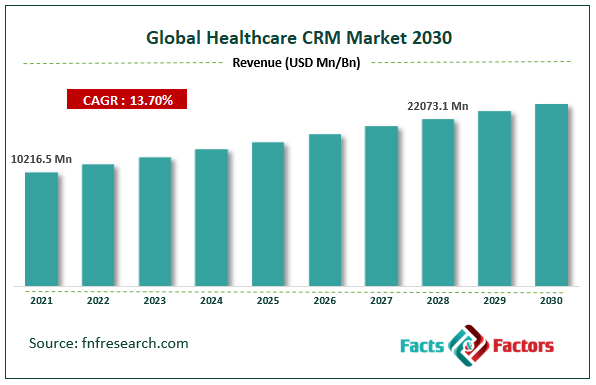Search Market Research Report
Healthcare CRM Market Size, Share Global Analysis Report, 2022–2028

Healthcare CRM Market By Components (Software, and Services), By Deployment Model (On-premise Model, the Web/Cloud-based Model), By Functionality (Customer Service and Support, Marketing, Sales, Digital Marketing, and Other Functionalities), By End-User (Healthcare Providers, Healthcare Payers, and Life Sciences Industry), and By Region - Global and Regional Industry Trends, Market Insights, Data analysis, Historical Information, and Forecast 2022–2028
Industry Insights
[205+ Pages Report] According to Facts and Factors, the global healthcare CRM market was worth around USD 10216.5 million in 2021 and is estimated to grow to about USD 22073.1 million by 2028, with a compound annual growth rate (CAGR) of approximately 13.7% over the forecast period. The report analyzes the healthcare CRM market’s drivers, restraints/challenges, and the effect they have on the demands during the projection period. In addition, the report explores emerging opportunities in the healthcare CRM market.

 Healthcare CRM? Market: Overview
Healthcare CRM? Market: Overview
Healthcare CRM is used to acquire a massive amount of patient data from many sources. CRM solutions are rapidly being used by healthcare organizations to improve sales, services, and marketing activities, as well as to obtain a higher Return on investment (ROI). CRM technology enables the automation of tasks like communicating test results and sending emails and text messages. Cloud-based technology is used to maintain an efficient healthcare CRM, such as social CRM. The enormous increase in the healthcare industry around the world is one of the key factors creating a positive outlook for the market in the forecast period. In addition, the growing demand for effective solutions to improve patient treatment and healthcare experience is propelling market expansion. As the coronavirus disease (COVID-19) spreads over the world, there has been a considerable increase in the demand for effective HCRM solutions in healthcare facilities for efficient patient monitoring.
These tools also help to reduce human effort, which leads to increased cost efficiency, reduced error risk, and improved communication. Other factors, such as rising mass healthcare expenditures and intensive research and development (R&D) efforts, are expected to boost market growth. Moreover, various technological breakthroughs, such as the integration of the Internet of Things (IoT), artificial intelligence (AI), machine learning (ML), and cloud computing solutions with the HCRM platforms, are also driving expansion. Through chatbots and real-time interactions, these systems deliver high-quality virtual care, home care, and remote illness monitoring services to patients. These factors will drive the market growth in the approaching years.
 COVID-19 Impact:
COVID-19 Impact:
The COVID-19 pandemic had a hugely significant impact on healthcare facilities. There was a steady and massive demand for an integrated system to manage workflow and provide effective help and care to patients all over the world. Focusing on patient communication is especially critical in light of changing healthcare coverage requirements and the extra burden of a potential pandemic. The use of data technologies, analytical, and digitalization technologies has significantly influenced the healthcare IT business. To deal with the rapidly growing patient populations, several healthcare institutions developed unique treatment options in response to the COVID-19 epidemic.
Those at the forefront, saddled with old employee communication and patient engagement systems that could not be expanded, quickly began adopting digital solutions to keep up with the enormous demands placed on staff and clinical teams. The emergence of COVID-19 has compelled industry participants to focus on research and development in order to improve and innovate in the Healthcare CRM market.
 Growth Drivers
Growth Drivers
The Healthcare CRM system is used to collect vast amounts of patient data from numerous sources. One of the important elements driving the expansion of the global healthcare CRM market is the increasing need for virtual care. Cost-effectiveness, lower error risk, and technical improvements are driving the industry. Healthcare CRM enables interaction between healthcare facilities and patients. Because the number of hospitals is steadily expanding, there is a high demand for healthcare CRM, which is moving demand to an integrated healthcare system for effective workflow. Some of the key factors for the growth of the worldwide healthcare CRM market include an increasing number of chronic diseases, an aging population, a demand for new technical advancements, virtual care for patients, and operational efficiency.
 Restraints
Restraints
During the projected period, the market is expected to grow. However, one of the key challenges likely to stymie market growth is the difficulties associated with CRM applications and expensive expenses. Increasing security threats and worries about patient data privacy are some factors that may limit market expansion to a certain extent.
 Opportunities
Opportunities
Improvements in accessibility, user satisfaction, efficiency, and quality can all be made possible through integrated healthcare. Integrating a healthcare CRM system is a concept that blends delivery management with healthcare organizations concerned with treatment, rehabilitation, health promotion, and diagnostics. Several organizations are emerging in the healthcare CRM market and increasing their operations through product launches, acquisitions, partnerships, and joint ventures.
 Challenges
Challenges
Healthcare CRM systems face some hurdles in order to survive in the market. There is a shortage of healthcare specialists, or they are too busy learning about the new system to incorporate them on a daily basis. Connectivity to numerous programs is required for the healthcare CRM. Furthermore, many healthcare facilities have strict laws and regulations for data access, which may make it difficult for healthcare CRM to flourish in the worldwide market.
 Segmentation Analysis
Segmentation Analysis
The Healthcare CRM Market is segregated based on component, deployment model, functionality, and end-user.
By component, the market is categorized into Software and Services. The software segment is expected to dominate the market during the forecast period because healthcare CRM software provides benefits such as improved patient experience, connectivity, and service quality, which improve medical data and information management, administrative duties, and process optimization. The services segment is anticipated to expand rapidly during the forecast period, as healthcare CRM as a service offers better accessibility, agility, and security to organizations.
By deployment model, the market is classified into On-premise Model, the Web/Cloud-based Model. The web/cloud-based model segment is likely to dominate the market. The web/cloud-based model segment is growing due to benefits such as minimal maintenance costs, robust security measures, and increased data accessibility and recoverability. CRM offers a cost-effective solution that is projected to propel the market more during the forecast period. Due to the benefits of on-premises CRM software such as full control over processes and systems, as well as cost-effectiveness, the on-premises category is likely to grow at a stable rate in the near future (as several vendors charge based on usage).
By functionality, the market is classified into Customer Service and Support, Marketing, Sales, Digital Marketing, and Other Functionalities. Customer service and support are predicted to account for the majority of the market share. The increased emphasis on patient interaction, rising pressure on healthcare businesses to decrease costs, and the importance of guaranteeing customer happiness are all important drivers driving this segment's size.
By end-user, the market is classified into Healthcare Providers, Healthcare Payers, and Life Sciences Industry. The healthcare providers segment is anticipated to dominate the market during the forecast period, because of the increased usage of healthcare CRM in hospitals and clinics. Furthermore, increased CRM deployment to optimize sales and marketing processes in pharmaceutical and biotechnology firms, as well as contract research organizations (CRO), is likely to drive segment growth throughout the projection period.
 Report Scope
Report Scope
Report Attribute |
Details |
Market Size in 2021 |
USD 10216.5 Million |
Projected Market Size in 2028 |
USD 22073.1 Million |
CAGR Growth Rate |
13.7% CAGR |
Base Year |
2021 |
Forecast Years |
2022-2028 |
Key Market Players |
Salesforce.com, Inc. (US), SAP SE (Germany), Oracle (US), Microsoft (US), IBM (US), Influence Health (US), SugarCRM (US), Accenture (Ireland), Healthgrades (US), and Infor, Inc. (US)., and Others |
Key Segment |
By Component, Deployment Model, Functionality, End-User, and By Region |
Major Regions Covered |
North America, Europe, Asia Pacific, Latin America, and the Middle East & Africa |
Purchase Options |
Request customized purchase options to meet your research needs. Explore purchase options |
 Regional Landscape
Regional Landscape
North America is expected to hold the largest share of the global healthcare CRM market during the forecast period, due to the existence of well-established healthcare facilities and increased awareness about healthcare IT solutions among hospitals and clinics in the area. Moreover, the presence of a high number of service providers in the region is boosting the market in North America.
The Asia Pacific market is expected to develop at the fastest rate during the forecast period, owing to increased government funding for healthcare organizations to improve patient care management and hospital management systems in order to provide better services to patients and their families. Furthermore, increased awareness among pharmaceutical businesses in emerging countries to streamline operational and marketing processes is expected to boost the Asia Pacific market in the near future.
 Recent Developments
Recent Developments
- In 2020, SugarCRM Inc. purchased Loaded Technologies Pty Ltd. The agreement will help SugarCRM expand its expertise to satisfy the demand for deployment services for time-aware, AI-driven marketing, sales, and support apps in Australia and the Asia Pacific area, allowing organizations to provide a better user experience.
- In 2020, Infor, Inc. purchased Intelligent InSites, Inc. The relocation would provide numerous advantages to Infor, Inc.'s current and prospective healthcare clients. It would be advantageous for the company to have more clinically related applications that link company applications to the caregiving system.
 Competitive Landscape
Competitive Landscape
Some of the main competitors dominating the Healthcare CRM Market include -
- Salesforce.com Inc. (US)
- SAP SE (Germany)
- Oracle (US)
- Microsoft (US)
- IBM (US)
- Influence Health (US)
- SugarCRM (US)
- Accenture (Ireland)
- Healthgrades (US)
- Infor Inc. (US).
Healthcare CRM Market is segmented as follows:
 By Component Segment Analysis
By Component Segment Analysis
- Software
- Services
 By Deployment Model Segment Analysis
By Deployment Model Segment Analysis
- On-premise Model
- Web/Cloud-based Model
 By Functionality Segment Analysis
By Functionality Segment Analysis
- Customer Service and Support
- Marketing
- Sales
- Digital Marketing
- Other Functionalities
 By End-User Segment Analysis
By End-User Segment Analysis
- Healthcare Providers
- Healthcare Payers
- Life Sciences Industry
 By Regional Segment Analysis
By Regional Segment Analysis
- North America
- The U.S.
- Canada
- Mexico
- Rest of North America
- Europe
- France
- The UK
- Spain
- Germany
- Italy
- Nordic countries
- Denmark
- Finland
- Iceland
- Sweden
- Norway
- Benelux Reunion
- Belgium
- The Netherlands
- Luxembourg
- Rest of Europe
- Asia Pacific
- China
- Japan
- India
- New Zealand
- Australia
- South Korea
- Southeast Asia
- Indonesia
- Thailand
- Malaysia
- Singapore
- Rest of Southeast Asia
- Rest of Asia Pacific
- The Middle East & Africa
- Saudi Arabia
- UAE
- Egypt
- Kuwait
- South Africa
- Rest of the Middle East & Africa
- Latin America
- Brazil
- Argentina
- Rest of Latin America
Industry Major Market Players
- Salesforce.com Inc. (US)
- SAP SE (Germany)
- Oracle (US)
- Microsoft (US)
- IBM (US)
- Influence Health (US)
- SugarCRM (US)
- Accenture (Ireland)
- Healthgrades (US)
- Infor Inc. (US)
Frequently Asked Questions

Copyright © 2024 - 2025, All Rights Reserved, Facts and Factors


